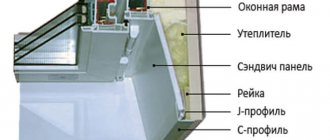Plastic windows lead the construction market in terms of their popularity. Joinery products made of polyvinyl chloride have good thermal protection and sound insulation properties. They are durable, practical and relatively inexpensive. They do not need to be sealed for the winter, painted, and are not at all difficult to keep clean. Thanks to these qualities, PVC windows are in constant demand among consumers. Polyvinyl chloride structures are used in both individual housing construction and mass construction. However, PVC windows have one peculiarity - in the autumn-winter period they often “cry”. Why does condensation form on the window surface? And how to avoid such trouble?
Nature of condensate
Fogging of glass is a physical process in which a liquid, under the influence of temperature, changes from one state to another.
Warm air contains some moisture in the form of vapor. As soon as the degrees drop, the steam turns into a liquid and settles on surfaces with low temperatures. And the window in any apartment is the coldest place. This means that the steam, turning into water, will settle on it.
If the moisture content in the air is high, window condensation can become a serious problem for apartment residents. Fogging will spread to other building structures of the building and will moisten them, forming mold and fungal pockets. In winter, the condensate will quickly turn into a state of frost, which can destroy the settling surfaces.
Condensation outside the window
Formation of condensation outside the glass unit
External fixation of condensate
This particular problem is actually quite rare and is a plus in most cases! This is a sign that your windows are well insulated. In faulty or poor-quality appliances, heat transfer occurs in which heat from the inner panel passes through the air gap and heats the outer panel.
Where the heat exchange process is prevented due to the thermal properties of the sealed unit, moisture can condense, causing condensation.
While this can be quite annoying as it obviously obstructs your view outside the window, it is a sign that your windows are in good condition and are preventing too much heat loss.
The concept of “dew point”
The “dew point” is the temperature at which cooling vapor turns into liquid. Such a point can be located anywhere in the wall insulation. It cannot be seen visually, but can only be seen on the corresponding graphs and maps.
Condensation is equally affected by temperature and humidity. And the lower the humidity in the room, the lower the dew point will be. In addition, the dew point is influenced by:
- external temperature;
- density of the wall “pie”;
- humidity and temperature in the room;
- as well as environmental humidity.
Danger of condensation
A high-quality and hermetically installed double-glazed window guarantees comfortable warmth in an apartment or private house. However, such a window blocks the access of fresh air to the room and disrupts the microclimate inside it that is favorable for humans. And condensation on plastic windows just indicates a violation of the microclimate in the home. High humidity actively contributes to the proliferation of harmful bacteria in the house, the formation of fungus and mold.
Optimal conditions, according to SNIP 2.04.05-91, are:
- temperature 20-22°C;
- and moisture content 30-45%.
The risk of windows fogging then becomes minimal. And since the double-glazed windows still begin to “sweat,” this means that there is a violation of the favorable climate in the room.
Defogging products
Constantly treating glass with specialized products will help remove moisture. But there are also several effective folk methods that get rid of condensation .
- Special products create a protective film that repels moisture. You can purchase the “miracle spray” in departments selling household chemicals.
- If it is not possible to purchase a special liquid for condensation, use folk remedies:
- Saline solution is an effective method in the fight against moisture. Dissolve a tablespoon of salt in 3 liters of water. Wipe the window with the resulting solution twice a day.
- The soap solution creates a film and repels water. Dissolve any detergent in 1 liter of water. Wipe the glass with the resulting liquid first with a damp sponge and then dry.
- Alcohol protects against moisture, however, it is recommended to use it only in a cool room.
There are many reasons why double-glazed windows fog up. To eliminate this unpleasant moment, it is necessary to observe the temperature regime and control the air humidity in the room.
Causes of condensate sedimentation
Fogging of surfaces is usually a consequence of lack of heating. This is when steam begins to settle on the window. There are several reasons for condensation:
- significant difference in temperatures inside and outside the room;
- high moisture content in the home;
- moisture release from low-quality finishing materials (paint, plaster, etc.);
- poor-quality (including independent) installation of window slopes with violation of the tightness of structures;
- installation of wide window sills that form obstacles to the entry of warm air from the radiators to the windows;
- installation of a double-glazed window with one chamber, which is inferior in terms of thermal insulation to two-chamber or more packages.
How to eliminate the threat of window fogging
Having found out why plastic windows sweat from the inside in an apartment, it is necessary to develop a strategy on how to deal with this phenomenon. There are only two reasons for the appearance of dew on windows from the inside - high humidity and low temperature in the window area. The glass does not warm up enough and cools to the dew point. By eliminating at least one of the reasons, you will eliminate the possibility of fogging.
But, as with all diseases, this must be dealt with comprehensively:
Provide heat to the window area.
Reduce humidity levels.
Organize full air circulation.
All these problems can be solved without any special financial costs (in most cases), but sometimes more radical intervention is required.
Increase in temperature near the window
The easiest way to do this is if the apartment is equipped with an autonomous heating system. In this case, it is enough to correctly adjust the boiler and open the control valves on the radiators located under windows that are prone to fogging on the inside. If dew appears inside the double-glazed window, this will not help - you need to change the double-glazed window. If the window is under warranty, there will be no problems, but it will be worse if it was purchased on the market from unknown sellers.
If the apartment has central heating, then you need to inspect the entire heating system:
- clean radiators;
- install control valves;
- increase the number of sections under the windows;
- replace radiators with more efficient ones;
- additionally install a fan heater.
Sometimes the room is warm enough, but the windows still sweat. In this case, you can replace the curtains with less dense ones or install a narrower window sill that does not block the path of warm air from the radiator to the window.
Reducing indoor humidity
The most effective way to reduce indoor humidity is regular ventilation. Even if the relative humidity is higher outside, this will have a positive effect. The air temperature there is always lower than in the room, which means the air contains a lower water content.
When measuring humidity in a room, we determine only one value - relative. It is obtained by dividing two other indicators, the absolute actual and the absolute permissible at a given temperature, and multiplying by 100.
The first number, the actual one, shows how much water is in the atmosphere in g/m3 at the moment. The second is how much it can theoretically be present before condensation begins at a given temperature. The less heated the air outside is, the less water it contains in real terms, even at higher relative humidity.
When drier outside air enters a room, it mixes with the inside air and “drains” it. This is all the more useful since fresh oxygen also enters the house, which has a beneficial effect on the general condition of the microclimate.
When ventilating an apartment in winter, it is possible to reduce the relative humidity from 50 to 30 - 35% without unnecessary financial costs. It is enough to periodically open the doors for 10 - 15 minutes. But in severe frosts, this method is not only inconvenient, but also unsafe both for the people in the house and for the window itself. You can easily catch a cold, and on the window there is a risk of ice forming on the seals and even their rupture. In cold weather, rubber, silicone and TPE become more rigid and can be easily damaged.
A more modern and practical way to organize air circulation is supply and exhaust ventilation. To do this, you will need to install supply valves and adjust the operation of the hood. Without much effort, you can restore the same ventilation mode that worked with old wooden windows.
Air exchange in a volume of up to 30 m3/h per person living in the house is considered normal. It was with this in mind that standard multi-storey buildings were built, in which plastic windows most often fog up. After all, they were designed for wooden windows, which, as already mentioned, are not highly airtight and allow enough outside air to pass inside.
Organization of air flow
The first step is to check the operation of the exhaust system. This is quite simple to do - open the sash of any window and attach a sheet of paper to the exhaust ventilation hole in the kitchen, bathroom, etc. If the air flow presses it against the decorative grille, the ventilation is working properly. In case of insufficient flow force, it is necessary to install an additional exhaust ventilation channel. The optimal place is the outer wall of the kitchen. Both a conventional adjustable grille and a forced system with an electric motor are appropriate here.
The next step is to check the ventilation gaps of interior doors, especially those leading to the kitchen, bathroom, and toilet. There must be a gap of at least 1.2 - 1.5 cm in height between the floor and the bottom cut of the door leaf. If there is none, install special transfer valves. They do not spoil the appearance of the door at all, but they greatly influence the microclimate in the house, equalizing the atmospheric characteristics in all rooms.
Long thick curtains, grilles, window sills lined with pots of flowers and tables and sofas moved towards radiators also actively interfere with air exchange; the distance to the nearest piece of furniture from the plane of the radiator should be at least 45 cm.
Window sills should also not protrude above the top edge of the battery; it is best if they are no more than 1 - 2 cm wider than the wall, in which case convection currents move along the desired path and ensure proper heating of the window area.
But without an influx of fresh air, all these tricks will not allow you to achieve a full result. It is necessary to organize supply ventilation, and constantly operating one.
The main role of supply ventilation is to provide access to the interior of colder but also drier external air, both in summer and winter. There is no need to worry that the house will become too cold. If it was warm with wooden windows, then it will be comfortable with metal-plastic windows with additionally installed channels for the supply of fresh air. The difference will be 1 - 2 degrees downward on very cold days and will be practically not noticeable on ordinary days.
The course towards complete sealing of apartments using metal-plastic windows, which was advertised as one of the main advantages of these structures, gradually changed in the opposite direction. Manufacturers, of course, did not publicly admit their mistake, but in most European countries the sale and installation of PVC windows without an air exchange system is not allowed.
But windows with built-in microventilation systems appeared on the market relatively recently, and, as a rule, windows that have been in use for more than one year sweat. How to be in this case? Installing an air conditioner is a hopeless path. The vast majority of these structures are designed not to recirculate indoor air, without taking in fresh air from outside. If changes in humidity can be achieved, it will only be at the level of small fractions of a percent.
There are several practical and inexpensive ways to organize fresh ventilation in any home. The most convenient and inexpensive is the installation of wall or window supply valves. These are relatively inexpensive devices, which, moreover, are quite easy to install. You can try to do this yourself, but it is better to invite specialists, especially if the house has recently been renovated.
Wall valves.
Installation of wall valves requires punching through holes in external walls, which are distinguished by their large thickness and fairly high strength materials. To regulate the amount of incoming air, there is a damper installed on the side of the room. You can buy either a valve with manual adjustment or an automatic one, the damper position of which is set by an electric drive powered by a hygrosensor that responds to changes in humidity in the room.
The productivity of wall valves is quite high - up to 50 m3/h; you will need 1 - 2 of them in a house. With normal adjustment and installation in different rooms, they are able to completely provide a house or apartment with fresh air necessary to maintain a normal microclimate.
The valve diameter ranges from 40 to 130 mm, which requires special equipment for drilling concrete or brick. And the valve itself, in fact, is an ordinary plastic pipe, covered on the street side with a mesh to protect against dust and insects.
On the wall side the pipe is protected by a layer of thermal insulation. There are a number of requirements for valve installation that are not mandatory, but if they are met, the most efficient operation of the device is achieved.
Basic installation requirements:
- height from the floor - in the range of 1.8 - 2 m;
- distance from the window opening - 10 - 15 cm;
- installation on the side of the opening sash.
Such distances and the installation method make it possible to easily mask the valve with a curtain or curtain, easily adjust it and, if necessary, clean the external filter by taking it out of the window. This operation must be performed at least 2 times a year on the first or second floor and 1 time a year in apartments located above this level - insects and dust rarely rise to the level of the third floor.
The part of the valve with holes for air supply should protrude from the wall no more than 2 cm. This makes it possible to fully blow with convection currents from the radiator and level out the influx of cold air. For the device to operate effectively, it is necessary that the distance from the air supply channel to the plane of the curtain be at least 5 cm.
Window valves of the supply ventilation system.
This type of device for regulating the amount of air entering the house is different in that for its installation it is necessary to disrupt the structure of the window itself. At the same time, the noise insulation and heat insulation properties of the structure should not be impaired. It is best if the valves are installed during the window production process - in this case, neither the geometry of the sash nor its thermal characteristics are guaranteed to be affected.
There are two types of valves for installation on a window frame - built-in and overhead. The first ones are installed in the frame rebate behind the sash and reveal their presence only by the presence of cracks or holes on the top crossbar of the sash.
The second ones are noticeable by the protruding linings on the top sash and require some changes in the window design.
In terms of performance, built-in valves are several times inferior to overhead valves, but in small apartments they do an excellent job. For large volumes of ventilated premises, it is better to choose overhead valves, the performance of which is not inferior to wall valves (up to 50 m3/h).
However, their installation is somewhat more complicated than built-in ones - it is necessary to make long through slots in the upper crossbars of the sashes (with the exception of a few low-performance models). They have virtually no effect on the level of sound insulation of windows and heat-insulating properties, except for the flow of cold air into the house from the street. But even such valves can reduce the temperature in the house by hardly more than 1 - 2 degrees.
Both types of valves (wall and window) operate properly at temperatures down to -35 0C. Theoretically, the lower bar can be lowered even lower, but such frosts are observed very rarely. At T = -20, traces of frost may appear at the valve outlets. This is not a defect of the device - when too cold and dry air comes into contact with the atmosphere of the house, moisture condensation is inevitable. This phenomenon does not pose a threat to the temperature in the room or the integrity of the valve itself. In most cases, frost will evaporate even without water droplets forming on the surface of the window or valve body.
How to choose a supply valve
You can choose the necessary device that is fully suitable in terms of performance and other qualities from products of almost ten brands. The best among them in terms of price/quality ratio are Aereco, Regel-Air, Air-Box, KIV. Good equipment is offered under the brands Sinax, Domvent, CleanAir. If you add installation costs to their cost, the price of one device will reach 3.5 – 4 thousand rubles. Considering their almost unlimited service life, the costs of arranging supply ventilation can be considered minimal, which will pay off in a year or two of use.
Another important recommendation for choosing devices for supply ventilation is the advice to use the services of professional ventilation system installers. They will accurately determine the recommended direction of air flow, based on the configuration of the apartment, accurately calculate the throughput of the valves, and help you choose their optimal combination.
The peculiarities of the movement of air flows require taking into account not only the size of the apartment, but even its orientation to the cardinal points. A properly developed project will not only achieve the maximum effect of the system, but also reduce the costs of its installation and operation, and also avoid the question of why plastic windows cry.
Condensation and wooden windows
But condensation practically does not settle on wooden windows. And all because they perfectly allow air to pass through due to the natural characteristics of the material they are made of, that is, wood. Therefore, the risk of disruption of the microclimate inside a room equipped with such window structures is practically eliminated.
Wooden double-glazed windows are not as airtight as plastic ones. And this also helps maintain normal humidity in an apartment or private house. And to avoid any problems with condensation at all, you just need to ventilate the rooms in such housing every day. That's all the preventive measures.
Why do plastic windows sweat in a private house?
Often, residents of private houses are faced with the problem of plastic windows fogging up. The problem may be hidden both in the factors already described and in some other factors. First of all, this is the use of incorrect materials during construction. Poor quality sealing of double-glazed windows also negatively affects the thermoregulation of windows. The lack of ventilation or its low level of operation will certainly affect the accumulation of dew on the glass.
Rice. 14. Some people neglect to protect the polyurethane foam layer.
Low quality material
Most finishing materials have a low vapor permeability threshold or do not provide for it at all. The ability of the material to pass steam is necessary to remove it outside, since otherwise it settles on the windows. For example, many resort to priming the walls before installing windows. This material has a detrimental effect on this indicator. Vinyl or non-woven wallpaper reduces the level of vapor permeability to nothing. You may notice that windows with wooden frames sweat much less often. This is achieved by the presence of pores in this material, which draw unnecessary moisture from the room.
Poor sealing of glass units
Poor sealing of double-glazed windows leads to the appearance of a gap through which heat escapes, which is why the glass does not receive sufficient heating and is an excellent place for the accumulation of harmful condensation, which provokes the appearance of fungi. Problems with sealing often arise not even due to low-quality material, but due to the negligent behavior of craftsmen who incorrectly measure the frames and do not fasten the double-glazed windows tightly enough.
Rice. 15. Improper sealing of double-glazed windows leads to dew.
Lack of ventilation
Ventilation systems are designed to pull out moist air and bring fresh and dry air inside the room. Fogging of plastic windows in a house where there is no ventilation is a completely natural phenomenon. Liquid is always released into the air in places where people, animals, and plants live. This process is inevitable. An exhaust hood should be present in houses where there are many living organisms, the stove is constantly on, the laundry is drying, etc. If water-saturated air is not drawn out of the room, microdroplets will begin to gather together, forming large ones, and will certainly cover the windows with dew. Steam cannot accumulate in the air indefinitely even if it is sufficiently heated.
Rice. 16. Ventilation is a necessary thing in a private home.
Prevention of condensate sedimentation
Simple ventilation is not enough in apartments and private houses with plastic window structures. Here the list of preventive measures against the formation of condensation on double-glazed windows is significantly wider.
The list of measures also includes:
maintaining the most comfortable temperature, close to the standard temperature of 20-22°C;- ensuring a flow of fresh air, natural ventilation;
- insulation of the room from the outside;
- reduction of moisture content inside (up to 50%, minimum);
- eliminating sources of water entering the apartment/house (eliminating dampness in the basement, repairing the roof, etc.);
- increasing the heating of the glass unit (replacing old ones or installing additional heating radiators);
- removing indoor plants from window sills.
Why do plastic windows in an apartment sweat?
Windows in apartments fog up much more often than in private houses. In the latter, opening entrance doors, cold attics and good ventilation systems help remove dampness. This is not the case in apartments, so the windows begin to cry. Additional factors are a large number of inhabitants and indoor plants, rare ventilation, lack of a hood in the kitchen, temperature changes, recent renovations, and the presence of a large aquarium.
Irregular ventilation
As already mentioned, stagnation of air in the room makes it impossible for steam to escape beyond its boundaries, which increases the ability of plastic windows to sweat. Apartments are often not ventilated for fear of drafts, children living there who could catch a cold, and street exhaust gases that actively float in the air near the roads. Therefore, for several days, or even more, the apartment remains without ventilation and actively accumulates moisture coming from various sources. If the above reasons occur, it is better to purchase windows with the ability to leave a gap for air ventilation. This effect is possible by turning the handle 45 degrees. The flap forms a barely noticeable gap through which steam and a minimal amount of heat will escape.
Rice. 17. A closed window prevents humid air from leaving the room.
Lots of moisture sources
The human body and any other creature releases moisture through breathing and sweat. A large number of people and animals living in a small apartment produces a lot of steam. In addition, water from taps, aquariums, indoor fountains, constant drying of laundry indoors, cooking, and the presence of a large number of plants add fluids. Physical exercise and household chores increase the level of water excretion from the body, so windows will fog up more for those who lead an active lifestyle at home and neglect ventilation.
Rice. 18. Calculate how much moisture is formed in the air of your home per hour.
Repair
Building materials increase the level of humidity in the apartment, so during repair work the glass may regularly “cry”. Laying tiles, plastering walls, gluing wallpaper and other repair work often provokes condensation on the windows. This happens due to the accumulation of moisture in the materials used to finish the walls, ceiling and floor. Such materials can take several days or more to dry. Sometimes this process drags on for years, which often happens in new-build apartments.
Rice. 19. Recent renovations in the apartment may cause the windows to fog up.
Temperature difference between outside and inside the room
Cold frosty weather is often accompanied by the appearance of moisture on window glass. The air in the apartment is warmer; it collects steam coming from different sources. The steam is evenly distributed throughout the room, and when too much of it accumulates, the microparticles collect into droplets that have to go somewhere. They like to settle on cold surfaces such as tiles and glass.
Rice. 20. Condensation forms at the junction of two temperatures - cold and warm.
Indoor flowers on the windowsill
Plants make a room more lively, cozy, fresh, and also decorate the interior. But they are also a productive source of moisture. Flowers are a living organism that also breathes, like people and animals. We also water and spray them. The water that falls on the leaves and into the ground is not all absorbed by the plant; some of it evaporates and floats in the air in the form of microdrops, which immediately settle “in place” on the glass. The presence of radiators under the window sills helps remove moisture from flowers by heating the air. Warm air is known to increase the level of vaporization.
Rice. 21. The more flowers in the apartment, the more humid the air, which means the greater the likelihood of glass fogging.
Methods for eliminating window condensation
To remove condensation that appears on the window, you need to:
- promptly ventilate the room;
- place a thick burning candle on the windowsill (that is, ensure air convection);
- turn on the fan, creating a moving air flow near the window;
- use convection screens (special plates that direct warm air flow from heating radiators to the windows);
- apply automotive chemicals (anti-fog sprays) to treat double-glazed windows;
- use electricity, that is, lay foil tape, nitrochrome thread or conductive film operating under voltage (12V-24V) along the window perimeter;
- use supply ventilation valves aimed at maintaining optimal air exchange in the room.
Methods of disposal
Today, experts offer several effective ways to get rid of fogging on windows.
Ventilation valve
It is purchased in a specialized store, has a fairly budget price, and provides instant relief from the problem. But only if it is not associated with low-quality window frames. The ventilation valve is mounted on top of the window profile. This arrangement allows for increased flow of fresh air without drafts.
Expert opinion
Kukushkin Anatoly Sergeevich
Repair specialist
Sometimes the cause of condensation lies in poor installation of the window system. In this case, you will need to check the entire frame for possible holes and foam them well. It happens that the only solution is to insulate the house from the outside or install energy-saving double-glazed windows.
Winter mode
In another way, this mode is also called micro-ventilation or micro-mode. Most window systems have it and help prevent water from appearing on the glass and window sill. With this system, the opening part of the window moves away from the frame by 1-3 mm. This small gap ensures the flow of fresh air, but at the same time retains heat in the apartment. With this mode, you don’t have to worry about freezing or catching a cold.
Ventilation
Excess water will not collect on the window frames if you constantly ventilate the room. It is especially important to do this in the cold season to equalize the temperature of the glass inside and outside. Many good quality window systems have special ventilation valves for automatic ventilation. Such systems virtually eliminate the appearance of traces of fogging even in the kitchen.
burning candle
This unusual method works great with cheap and expensive systems in the cold season. You need to put several candles on the windowsill and light them. The heat generated during combustion will prevent condensation from collecting. Usually, to eliminate fogging, thick candles with a diameter of 5-10 cm are used.
This method is more of an auxiliary nature and requires constant monitoring from the outside. Candles should not be left in the nursery or at night.
Convection screen
A more expensive solution, but it works great in warm and cold seasons. A convection screen is a small plate that can redirect air masses from the battery to the window frame. Such screens should be made slightly larger than the width of the heating equipment. They are usually installed at an angle of 30 to 60 degrees. You can purchase a convection system in specialized stores and immediately attach it to the battery.
Use of chemistry
A cheaper, but more effective way to combat fogging is regular automotive chemicals. It is enough to purchase an aerosol or liquid with an anti-fog effect and apply it to all windows. After spraying, be sure to wipe and dry the glass and window frame thoroughly. Automotive chemicals help reduce the amount of water several times, but cannot completely stop its formation. Anti-fog agents should be used 1-3 times a week, depending on the complexity of the problem.
Ventilation system
The fan will provide a constant flow of air. It should be placed on the windowsill. In order not to provoke the opposite effect, the fan must be turned on at minimum power. If there are several windows in a room, you need to install equipment on all of them at once. There are small book-sized fans available in stores that are ideal for this task.
Electrical system
A rather original method that requires careful handling. The entire window frame is covered with foil or foil film. After this, a small generator needs to supply this structure with a current of 12-24 V. The foil will warm up and generate heat, which will prevent fogging of the windows.
It is important not to overdo it with the current, otherwise there is a risk of the foil igniting, which will lead to a fire.
Reasons for the formation of condensation on pipes
Unfortunately, indoor condensation can form not only on windows, but also on cold (only cold) water supply pipes.
The causes of condensation on plastic and metal water pipes may be as follows:
- Plumbing leaks as a result of poor installation or temporary wear and tear.
- Poor ventilation due to improperly organized exhaust system.
- Leaks in a neighbor's plumbing system or toilet cistern.
- A sharp temperature change in an apartment or private house (in the summer, for example, in some rooms water practically runs like a stream over the surface of cold pipes).
- Incorrect distribution of cold and hot water supply (for example, there is no thermal insulation of the pipes, plus they are located close to each other).
Why does condensation occur inside a plastic window?
Often condensation forms in the air chamber between the glass parts of a plastic window. This phenomenon occurs due to cooling. During the cold season, air from outside impacts the glass and tries to penetrate inside. The outside of the window inevitably lends itself to such influence. Getting into the space between the doors, the cold begins to affect the inner glass. This material perfectly attracts and holds it. It is usually warm inside at this time. The air in the room collects steam, which begins to seek out a cold surface. If there are cracks or crevices in the window, air of different temperatures will certainly mix inside the window and condensation will settle between the sashes. This is quite dangerous, since removing it from there is much more difficult than wiping the inner glass.
Rice. 2. To understand the problem of fogging of a plastic window, you need to understand how it is designed.
Rejection of a plastic window
A plastic window can be considered defective if it has an irregular frame shape, gaps in the sashes, or poor fastening of the fittings. All this contributes to the penetration of moist air inside. Such defects should be checked in the store to prevent subsequent red tape with dismantling and reinstallation.
Manufacturers are obliged to ensure the tightness of this type of product, since the slightest deviation from the technology can cause quite serious problems in the future. If the problem is discovered later, it can be fixed by replacing the glass unit. This procedure must be carried out by qualified specialists. Reputable companies provide a quality guarantee, so if there is a defect, they will replace the low-quality product free of charge.
Rice. 3. Defects in any component of a plastic window can lead to improper functioning of the entire installation.
Installation error
You can install a plastic window yourself, but in this case there is a risk of violating the installation rules, which leads to fogging of the structure from the inside. With high humidity, loosely installed sashes allow air and heat inside and provoke the accumulation of condensation. This not only spoils the appearance of the window, but also leads to mold. Therefore, it is better to contact experienced specialists.
Rice. 4. Incorrect installation is the first step to window fogging.
Presence of cracks in glass
There are cases of window damage during transportation and installation. Under no circumstances should you turn a blind eye to even a small and seemingly invisible crack. The mistake is to “fix it” yourself by purchasing some putties, adhesives, etc. This will not correct the situation. You'll just be throwing money away. Cracked glass must be replaced to protect yourself from drafts and fungal growth.
Rice. 5. The cracks release heat and help the glass cool down.
Installation of a single-chamber window
Another reason for windows fogging from the inside is the single-chamber design. It has only 1 layer and a small distance between the glasses. The gap between them does not exceed 30 mm, which reduces the level of thermal insulation. Experts do not recommend installing this model in residential areas, as it does not retain heat very well. We are often driven to purchase this type of window by the desire to save money. Therefore, the reasons for fogging of single-chamber plastic windows include not only low technical qualities, but also excessive savings.
Rice. 6. The more cameras in the window, the less likely it is to fog up.
How to get rid of condensation on pipes?
There are several ways to solve the problem:
- Check the hood. If debris or cobwebs have accumulated there, they should be removed. Then buy a compact fan and install it in place of the ventilation grille. Today's range of such devices allows you to choose an inexpensive but effective option.
- Insulate the cold water supply system with special tubes made of foamed polyethylene or energyflex (they are sold in all construction supermarkets). It should be remembered that such insulation is applied to completely dry pipes - this should be taken care of in advance and the pipeline should be dried.
- Completely insulate cold water supply pipes:
- sand them;
- treat with acetone;
- apply a rust converter;
- coat with epoxy putty;
- wrap strips of fabric over the damp putty in 2-3 layers;
- secure the edges of the material with a wire clamp;
- reapply the epoxy compound;
- sand the dried surface;
- and paint.
Methods for protecting metal pipelines
If metal pipes are not protected from condensation, over time, pockets of corrosion will form on them, leading to destruction. In such cases, the following steps should be taken:
Protect the pipe surface from rust using special compounds. After appropriate treatment, dry the surface, cover it with drying oil, and then paint it.- You can treat the surface of the pipeline with carbolate, a paste used to seal cracks. The composition is applied to the pipe in a layer of 5 mm and left to harden for a day. Then the surface is sanded and painted with oil paint.
- Treat the pipes with a protective primer (any commercially available one), consisting of zinc dust mixed with drying oil and epoxy varnishes. The surface coated with the composition and dried will then simply need to be painted.
- The pipeline in the toilet can also be coated with a composition of drying oil and red lead (in a ratio of 1:4).
- Some people advise putting a corrugation on the pipe (its diameter should be slightly larger than the diameter of the pipe), and filling the cavities with foam. This is also an effective solution.
- You can also make a plastic box around the pipe on which condensation occurs. And inside such a box, place a special absorbent tablet that can not only eliminate condensation on the pipe, but also normalize the humidity in the entire room.
- Install climate control air conditioning. This is an expensive method, of course, but nothing better than this can provide an optimal climatic atmosphere in an apartment or private house.
What to do if plastic windows sweat?
Regular ventilation of the room
If you are used to exercising at home, spend a lot of time at the stove, dry laundry in your rooms, or are a big fan of flowers, make a rule to ventilate your apartment or house every day. You don't need to do this for hours; 15 minutes twice a day will be enough. If it's frosty outside and you don't want to freeze, leave the window open when you go out to the store, walk the dog, visit your neighbors, or go somewhere else for a while.
Rice. 22. A specially left gap for the outflow of moist air will make it easier for the window to fog up.
Convection grilles on window sills
A wide window sill does not allow heat to pass through to the glass, which causes condensation. This problem can be eliminated by reducing its area. But a narrow window sill does not always look beautiful. If there is no possibility or desire to make it narrow, then the issue can be solved by installing a convection grille above the heating device, which is located under the window. It allows hot air to rise and warm cold glass, preventing steam from settling there.
Rice. 23. The correct placement of curtains and a narrow window sill will help the radiator warm the glass.
Choosing a double-glazed window
The number of glass parts in a plastic window affects its thermal permeability. Glass forming 2 chambers filled with air is more airtight and has higher performance. Single-chamber windows cool faster and provoke not only fogging, but also freezing. The presence of energy-saving film will significantly reduce the energy consumption of the window. This model also protects the cooling of the inside of the window, since all the cold air is retained by the other two – the middle and the outside.
Rice. 24. Choose windows with two cameras.
Insulation of external and internal slopes using polyurethane foam
Using polyurethane foam to insulate window slopes will only bring a positive effect if it is well protected on both sides from water, dampness, wind and sun. Flimsy strips that do not fit tightly to it will not help here. The loss of thermoregulating properties of foam often remains unrecognized, which makes it impossible to correct the situation and leads to the appearance of mold on constantly foggy windows. The decorative strip, behind which poorly done work is often hidden, may have cracks and will let dampness in. On the outside, the layer of polyurethane foam is sometimes not covered at all. Especially in private homes. Like, no one sees, less hassle. This leads to a layer of dew on the windows and mold.
Rice. 25. Do not leave foam uncovered.
Using a hood in the kitchen
In any residential building or apartment, the process of cooking is inevitable. Pots, pans, a kettle, and an oven, when heating water and food, provoke the release of steam, which is especially abundant in the kitchen. To avoid increased steam formation in this part of the house and remove all air saturated with excess water, you just need to install a hood in the kitchen and use it when preparing food. But even so, it doesn’t hurt to open the window for a while to fill the room with fresh air. Also, when working at the stove, you should close the kitchen doors so that steam saturated with food microparticles does not penetrate into the rooms. There it settles on the windows and is absorbed into furniture and clothing, leaving an unpleasant odor and contaminating glass surfaces.
Rice. 26. When cooking, turn on the hood.
Clearing window sills from flowers
Dense vegetation on the windows not only clutters the opening and blocks the path of light, but also contributes to the release of large amounts of moisture. To avoid the problem of window fogging, you need to clear the window sill of flowers and move them away from heating appliances. The same should be done with aquariums and fountains, the water from which evaporates faster near radiators and fireplaces.
Rice. 27. A significant reduction in the number of flowers on the windowsill will reduce the amount of water on the windows and protect them from the appearance of fungus.
Selecting quality window fittings
When choosing windows, resist the urge to save money and purchase quality products. You will have to pay a lot more in the future to try to get rid of mold and the health problems it causes. The fittings must fit perfectly to the window frame. If the handle is not locked “tightly” in the closed position, it is better to choose another one. The hinges must be attached firmly, leaving no gaps. The sashes should be carefully leaned against the frame.
Rice. 28. Replace low-quality fittings.
Installation of a plastic window by professionals
You should trust window installation only to qualified specialists, and not to “schemers” who are often in a hurry to complete the work quickly and do it poorly. They take the measurements incorrectly, do not securely fasten the elements of the future window, or seal the slopes with polyurethane foam. If you contact a special company that recruits good workers, you can get quality service and high results. In addition, such a company can give practical advice on window care and tell you the rules of operation. Some provide a guarantee to replace poorly installed parts.
Setting winter mode
Some options for plastic windows require two seasonal window opening modes: winter and summer. The second implies a smaller fit of the sashes to the frame. In summer, the window is required not to allow dust, dirt and hot street air to pass through. In winter, the window must also protect the room from the penetration of cold and prevent the occurrence of drafts. This is why winter mode exists. To understand whether it is provided, you need to inspect the window. If there are holes on the side of the sash for a hexagon or asterisk near the eccentrics, then the manufacturers have taken into account the possibility of switching the window to winter mode. However, this action must be performed carefully, since improper handling can damage the fittings.
Rice. 29. Switch the window to winter mode in time.
Air Vent Maintenance
Ventilation holes tend to become clogged, accumulate grease, and become clogged. This leads to poor functioning and negatively affects the condition of the windows. To check for draft, just hold a lit match to the hood or lean a sheet of paper against it. If it is attracted to the grille by the air flow, then there is draft. It is enough to clean the ventilation and kitchen hood once every few months to prevent further problems.
Rice. 30. Clean the ventilation in a timely manner.
If you take into account all the features of plastic windows, pay attention to their correct selection and installation, and ensure proper care of the room, you can avoid fogging and subsequent problems with dampness and mold.
Advice from professionals
Advice from experienced plumbers will help you effectively deal with condensation on pipes:
- Many people recommend using the Corrugated composition, which forms an elastic protective film on the surface being treated that prevents moisture formation.
- You can effectively use liquid thermal insulation against condensation, which is applied to a dry (necessarily) pipe like paint.
- Some experts recommend large-scale insulation of the pipeline. This is necessary when the ventilation, plumbing equipment and water supply are working properly, and the cause of condensation on the pipes is a temperature difference (the pipe and the air space surrounding it). The operation is performed using covers made of foamed polyethylene or Merylene, which can be easily purchased at almost any hardware store.
( 57 votes, average: 4.70 out of 5)
How to choose a desk for a schoolchild
Kitchen wall design
Related Posts
Questions and answers
Energy-saving bags will help avoid condensation on the frame?
Only if they are installed correctly.
Do the above methods work only on PVC windows or on other frames too?
All methods are equally effective on window frames made of various materials. It is enough to use the advice correctly.
Are automotive chemicals harmful for spraying indoors?
Such liquids contain aggressive components, but when used wisely they do not cause any harm to health.
If there is high humidity in the room due to a leaky roof or the window system itself, is there any point in dealing with condensation?
No, in this case you need to eliminate the main source of the problem and only then remove the fogging.
Why don't batteries help remove excess water from the window frame?
Heat does not spread as it should. This is why the screen is installed.
Condensation on windows is a common, but very dangerous phenomenon. As soon as the first signs of fogging are noticed, they need to be eliminated. Usually this problem is solved by ordinary ventilation, but sometimes it requires a more serious solution to prevent mold from growing.











